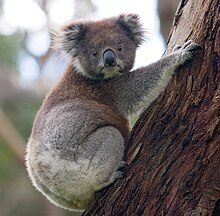Phascolarctos
| Phascolarctos | |
|---|---|

| |
| A Otway National Park , Victoria, Australia
| |
| Scientific classification | |
| Domain: | Eukaryota |
| Kingdom: | Animalia |
| Phylum: | Chordata |
| Class: | Mammalia |
| Infraclass: | Marsupialia |
| Order: | Diprotodontia |
| Family: | Phascolarctidae |
| Genus: | Phascolarctos Blainville, 1816 |
| Type species | |
| Species | |
| |
| Synonyms[2] | |
Phascolarctos is a genus of
Taxonomy
The genus was named by French zoologist Henri Marie Ducrotay de Blainville in 1816.[3][4]
The type species, the modern koala, was named as
An accepted synonymy of other generic names referring to Phascolarctos was published in 1988.
The name is derived from Ancient Greek φάσκωλος (phaskolos), referring to a leather pouch or bag, and ἄρκτος (arktos), meaning "bear".[9]
Description
Phascolarctos is a genus of large arboreal marsupials that has specialised in leaves of Eucalyptus, a poor quality and potentially toxic food source that is unavailable to most other native mammals.[10] The extinct species are presumed to have similar diet and habits to the modern koala, the largest Australian folivore, which was exceeded in size by the even more robust P. stirtoni.[11] The tail of koalas is almost absent, an unusual characteristic for a tree climbing mammal, although other anatomical features are well suited to that habitat. They have some resemblance to the wombats, a family of large terrestrial marsupials which are allied with koalas as Vombatiformes.[10]
The fossil material referred to the extinct species of this genus is scarce and fragmentary. Some remains are tentatively referred to Phascolarctos stirtoni, and the specimen for Phascolarctos maris, a partial lower molar, was later suggested by Karen H. Black to be an example of variance within the P. stirtoni species.[12]
Distribution
Phascolarctos species have been discovered as fossil remains in several regions across southern and eastern Australia, in South Australia, Queensland and Victoria, and still occurs in those states and New South Wales. The modern koala is also known in the fossil record of the southwest of Australia and many other regions, but no occurrence of a living or extinct Phascolarctos species is recorded in the states of Tasmania and the Northern Territory.[11]
The existing koala P. cinereus once had a wide range across the continent, which substantially contracted as a consequence of climatic changes that included extremes such as glacial cycles. Extinction of regional populations includes their disappearance from Western Australia after the mid to late Pleistocene, where their previous success is indicated by numerous fossils discovered in the Leeuwin-Naturaliste region. The disappearance from Southwest Australia coincided with a change in the region's fire regimes.[11]
The temporal range of the Phascolarctus species includes fossils dated to the early Pliocene and mid to late Pleistocene.[12] The earliest record of P. cinereus, the only species of the modern era, is dated to around 350 000 years ago. Phascolarctus is a remnant of a family that includes eight to ten genera, the Phascolarctidae, which diverged around 26 million years ago (during the Oligocene epoch).[11]
The records for Phascolarctos yorkensis (Pledge, 1992) include occurrences in Curramulka Local Fauna in South Australia and Wellington Caves in New South Wales, possibly datable to the late Miocene.[11]
Classification
Phascolarctos gives its name to the
Family Phascolarctidae[13]
- Genus †Nimiokoala
- Genus †Invictokoala[14]
- Genus †Madakoala
- Genus †Litokoala
- Genus †Koobor
- Genus †Perikoala
- Genus Phascolarctos
- Genus †Priscakoala[17]
A previously recognised arrangement of infraspecific taxa may be summarised as
- Phascolarctos cinereus Koala[9]
Three subspecies have been recognised within the existing species, based on specimens collected in Queensland, New South Wales and a "southern race" in Victoria. These may only represent clinal variation within the species at different latitudes,
References
- ^ Goldfuss, G.A. 1817. In Schreber, J.C.D. von (1774–1855). Die Säugethiere, in Abbildungen nach der Natur, mit Beschreibungen. Fortgesetzt von A. Goldfuss. 65e cahier. [pl. 155 Aa Bb]
- ^ "Phascolarctos". Global Biodiversity Information Facility. Retrieved 1 August 2021.
- ^ de Blainville, Henri (1816). "Prodrome d'une nouvelle distribution systématique du règne animal". Bulletin de la Société Philomáthique, Paris (in French). 8: 113–124.
- ^ "Genus Phascolarctos Blainville, 1816". Australian Faunal Directory. 6 October 2017. Archived from the original on 15 January 2021. Retrieved 2023-02-17.
- ^ In Schreber, J.C.D. von (1774–1855). Die Säugethiere, in Abbildungen nach der Natur, mit Beschreibungen. Fortgesetzt von A. Goldfuss. 65e cahier. [pl. 155 Aa Bb].
- ^ McKay, G.M. 1988. Phascolarctidae. pp. 51-52 in Walton, D.W. (ed.). Zoological Catalogue of Australia Volume 5. Mammalia. Canberra : Australian Government Publishing Service x 274 pp.
- ^ Determination that a distinct population of biological entities is a species for the purposes of the Environment Protection and Biodiversity Conservation Act 1999 (Cth) (132)
- . Retrieved 12 November 2021.
- ^ ISBN 9789048134281.
- ^ ISBN 0207144540.
- ^ .
- ^ a b c K J Piper. 2013 An early Pleistocene record of a giant koala (Phascolarctidae: Marsupialia) from western Victoria. Australian Mammalogy 27(2) 221–223
- OCLC 62265494.
- S2CID 84316375.
- ^ N. S. Pledge. 1987. Phoscolarctos maris, A new species of koala (Marsupialia: Phascolarctidae) from the Early Pliocene of South Australia. Possums and Opossums: Studies in Evolution 1:327-330
- ^ Bartholomai, Alan (1968). "A new fossil koala from Queensland and a reassessment of the taxonomie position of the problematical species, Koalemus ingens De Vis". Memoirs of the Queensland Museum. 15: 65–71.
- S2CID 86152273.
- .
- ^ Jackson, Stephen M. (2010). "Family PHASCOLARCTIDAE". Australian Faunal Directory. Retrieved 13 February 2022.
- ^ Kjeldsen, S.R., Raadsma, H.W., Leigh, K.A. et al. Genomic comparisons reveal biogeographic and anthropogenic impacts in the koala (Phascolarctos cinereus): a dietary-specialist species distributed across heterogeneous environments. Heredity 122, 525–544 (2019).
